Quinoa is a cereal grain that’s distinctively healthy thanks to a number of unique properties.
First, it is unusually high in antioxidants as far as grains go; this is in part because it’s closely related to plants like spinach, which are very rich in antioxidants. It’s a popular replacement for other grains for people who are on a gluten free diet, and it outclasses most other grains when it comes to their nutrient profile.
Further, quinoa contains all nine essential amino acids (most plants, even those rich in protein, only contain some).
Quinoa is a great base for hot cereal in the morning, or as a way to add in extra protein and antioxidants to a soup.
Looking for high-quality quinoa? We’ve ranked the ten top quinoa brands on the market, plus summarized the science behind the benefits of quinoa for your health.
Research
Rankings
1. Viva Naturals Royal Quinoa
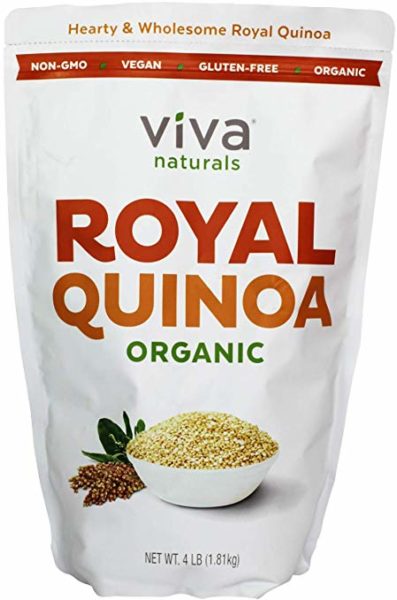
Viva Naturals Royal Quinoa makes the best white quinoa on the market, hands down. This organically grown quinoa is harvested in Bolivia and comes in a hefty four pound bag.
It’s pre-washed and carefully sifted to remove twigs and debris, so you don’t have to waste time sifting through the grains on your own. Thanks to all of these advantages, it’s our top pick.
2. Anthony’s Organic White Quinoa
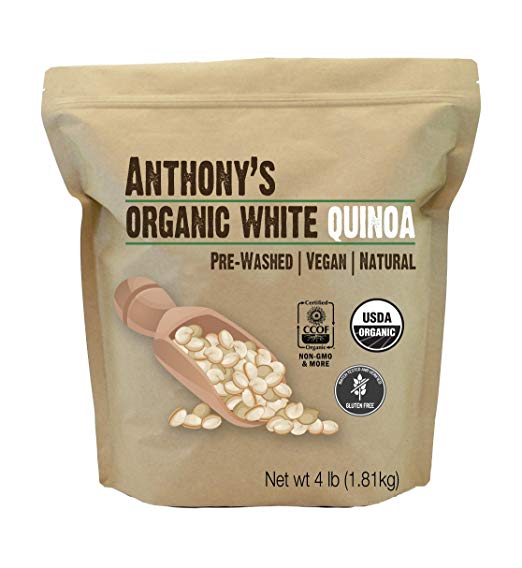
Anthony’s Organic White Quinoa is an excellent option for a bulk source of white quinoa.
It’s pre-washed, meaning you don’t have to soak or strain it to remove the bitterness of unwashed quinoa, and it’s organically grown in Peru. Anthony’s Organic White Quinoa is an excellent overall choice.
3. Pride of India Organic Red Royal Quinoa
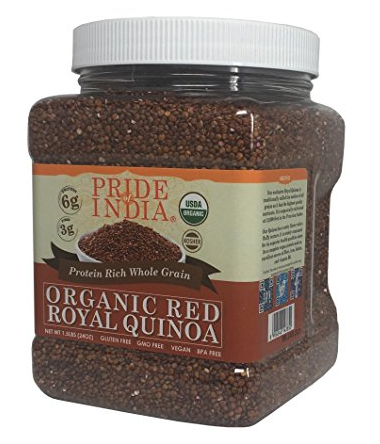
If you want a nutty, chewy flavor that’s got some extra antioxidants, give Pride of India Organic Red Royal Quinoa a try. This organically certified red quinoa comes in a 1.5 pound jar, which makes keeping your quinoa fresh incredibly easy.
4. Better Body Foods Organic Quinoa
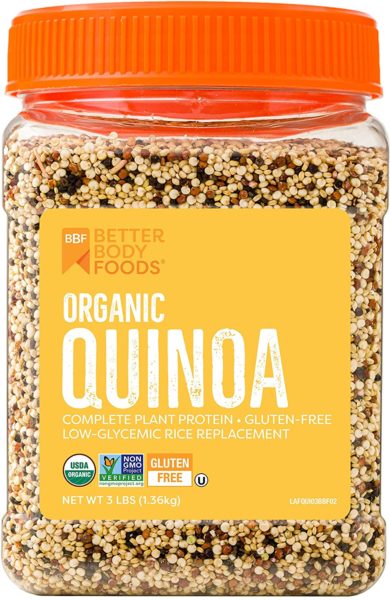
Better Body Foods Organic Quinoa makes a blend of white, red, and black quinoa, which gives it a robust flavor, nutty texture, and plenty of antioxidants.
The blend of the three most popular types of quinoa gives it a balance between the lightness and fluffiness of white quinoa and the deep, bold flavors and antioxidants in red and black quinoa.
If you want a well-balanced quinoa, Better Body Foods Organic Quinoa is a great choice.
5. Healthworks Whole Grain Quinoa
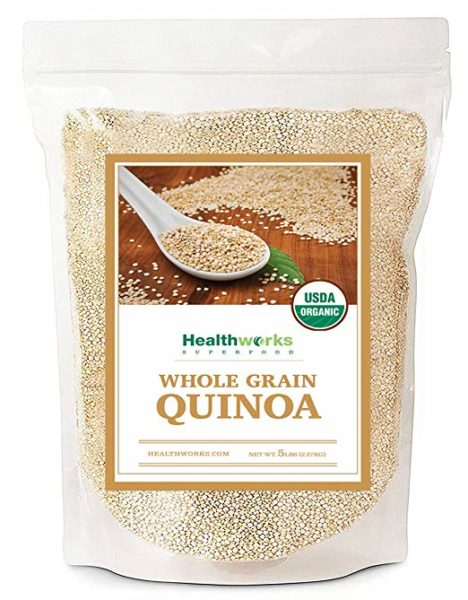
Healthworks Whole Grain Quinoa is a white quinoa that’s certified organic and comes in a resealable five pound bag. It cooks up with a light and fluffy flavor, which is par for the course for white quinoa
6. Kirkland Signature Organic Quinoa
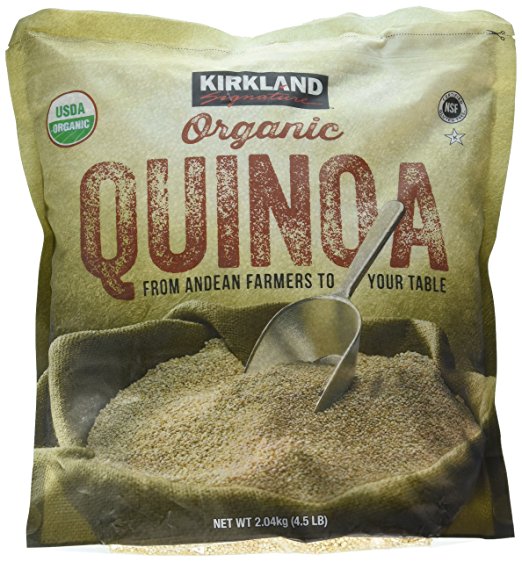
Kirkland Signature Organic Quinoa is a pretty straightforward white quinoa.
It’s organically certified and comes in a four and a half pound bag, and besides that, there aren’t any particularly distinguishing features that set it apart, so it’s hard to rank this product much higher, even though it’s still a pretty good choice.
7. Rice Select White Quinoa
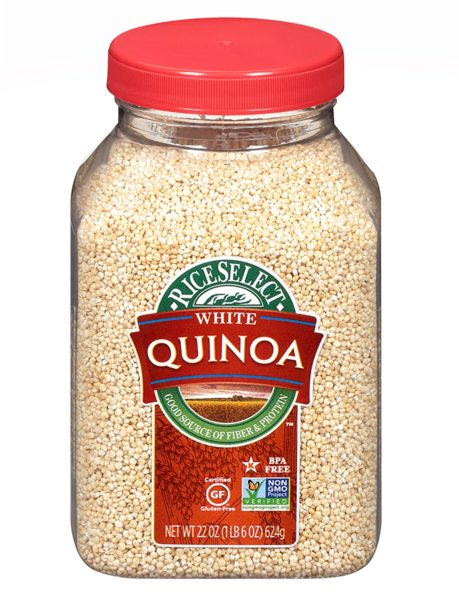
Rice Select White Quinoa is a pretty standard white quinoa that comes in a moderately-sized plastic tub. The 22 ounce size could a problem for many people who go through a lot of quinoa on a regular basis, or prefer cooking big batches at once.
If you fit into one of these camps, you’d be better served by a different product. On top of that, it isn’t organic, which might turn off some people.
8. Ancient Harvest Traditional Quinoa
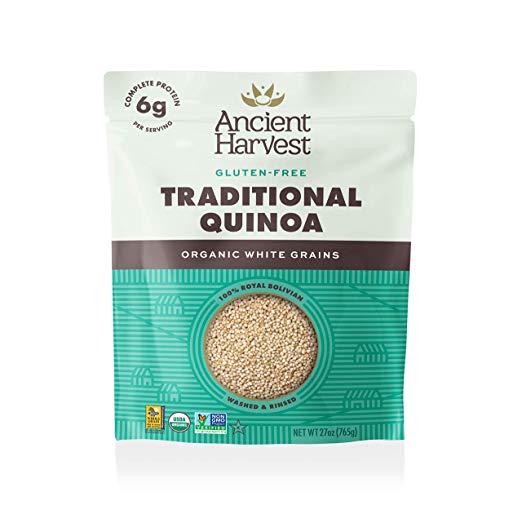
Ancient Harvest Traditional Quinoa is an organically certified white quinoa that comes in a 27 ounce package. Though it can be a bit difficult to reseal after opening, the flavor is good and the grains are pre-washed.
9. Nature’s Greatest Foods Black Quinoa
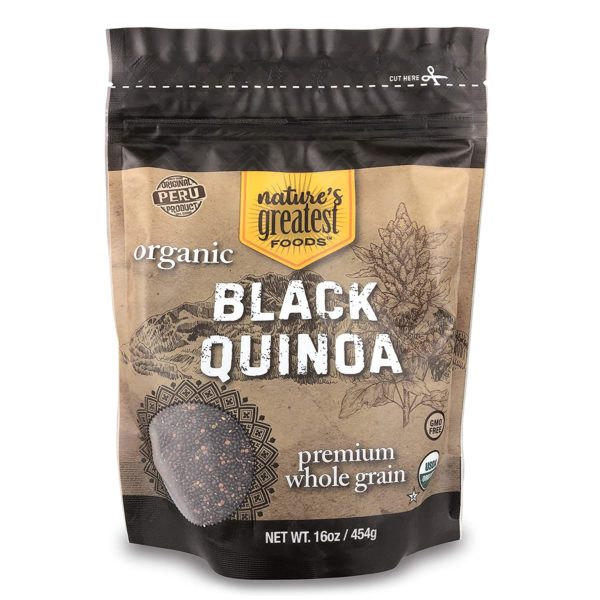
Black quinoa is arguably the healthiest type of quinoa thanks to its high concentration of antioxidants. It also has a bold, rich flavor, and Nature’s Greatest Foods makes one of the best black quinoa products out there.
The primary downside is the 16 ounce bag size—almost everyone is going to find themselves going through this package very quickly.
10. Roland Black Quinoa
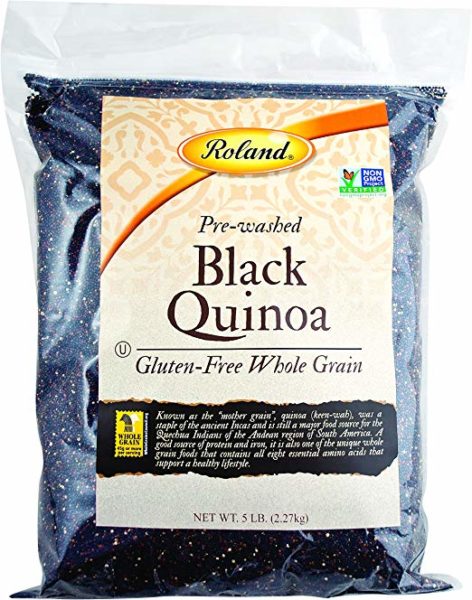
If you go through a lot of black quinoa on a regular basis, Roland Black Quinoa is a solid choice. It’s a no-frills option, and it’s not organically certified, but this large five pound bag is a solid choice for bulk users.
Category winners
Best quinoa overall: Viva Naturals Royal Quinoa
Viva Naturals takes our top overall spot thanks to its organic certification and larger, softer grains that give it an unbeatable texture. This royal quinoa is great as a staple, in salads, or just about any other recipe.
Best quinoa for weight loss: Pride of India Organic Red Royal Quinoa
Looking to replace unhealthy refined carbs with whole grains to lose weight? Pride of India is the way to go. This red quinoa has extra antioxidants and an exceptionally high fiber content, meaning it will fill you up and prevent hunger cravings later.
Best organic quinoa: Viva Naturals Royal Quinoa
Viva Naturals’ organic certification means you don’t have to worry about synthetic pesticides or fertilizers making their way into your food. Best of all, you don’t have to sacrifice on taste to get this benefit with Viva Naturals.
Best white quinoa: Anthony’s Organic White Quinoa
For a light, sweeter-tasting quinoa, go for Anthony’s Organic White Quinoa. On top of its organic certification, it’s pre-washed, meaning you don’t have to soak it before cooking, which makes for quicker and easier meals.
Best red quinoa: Pride of India Organic Red Royal Quinoa
Red quinoa boasts greater antioxidant levels than white quinoa. If you’re looking to take advantage of this, Pride of India is our pick—it cooks up with a dense, nutty flavor that’s great as the centerpiece of a meal.
Best bulk quinoa: Healthworks Whole Grain Quinoa
This five pound bag of Peruvian quinoa is a great buy if you go through a lot of quinoa on a regular basis. On top of the bulk size, it’s also organically-certified, which is a great additional benefit.
Who should buy quinoa?
Quinoa is safe for individuals of all ages and is great superfood packed with nutrients. Persons suffering from a gluten intolerance such as celiac will be able to consume quinoa since it’s gluten free.
Quinoa can be safe for diabetics since it has a low GI and is great for individuals that are overweight or trying to lose excess weight.
How we ranked
Quinoa contains a natural pest repellent called saponin. While eating saponin won’t hurt you, but it tastes really bitter, which makes it important to wash off. However, most strainers aren’t actually fine enough to keep the grains from getting everywhere, so that can be a hassle. As such, we preferred products, like Better Body Foods and Alter Eco that were pre-rinsed. Regarding GMO and organic certifications, since quinoa isn’t a genetically modified grain, all quinoa in its raw form is non-GMO.
Quinoa comes in 3 colors: black, red, and white. Nutritionally, they are nearly identical, even though they taste differently. Red and black quinoa have a chewier texture than white, which is the least bitter. White quinoa, like Viva naturals, is the fastest-cooking quinoa, which was why we preferred it over other colors. Rainbow or tri-color quinoa was not preferred because of the different cooking times needed for each color of quinoa.
Quinoa is as a gluten-free grain; however, there can be some cross-contamination, making it unsafe for celiac patients. One study that looked at 15 strains of quinoa found that two actually contained measurable levels of gluten. For our rankings, we preferred products that were certified gluten-free, as to avoid any complications.
Benefits
Quinoa is a seed that is rich in fiber, antioxidants, and micronutrients. Technically classified as a seed, quinoa is a rich source of antioxidants, trumping grains like rice and barley while scoring even higher than cranberries. (1)
Since it’s usually prepared and eaten in the same way, it’s considered a whole grain and has an impressive nutritional profile. The nutty, crunchy texture makes it a good alternative to cereal, and it’s also gluten-free.
Along with buckwheat and amaranth, quinoa is sometimes referred to as pseudo-grain or pseudo-cereal. The tiny oval-shaped seeds are usually yellow, but may be pink or black, with taste ranging from sweet to bitter; the bitter seeds are highest in antioxidants.
Quinoa is often boiled and served as a side dish, but it can also be sprouted, popped like corn kernels, or even used as a baby food. (2)
Quinoa is exceptionally high in protein. At 15% protein, which is higher than most grains, quinoa offers substantial health benefits including a variety of vitamins and minerals, as well as a stellar amino acid composition that makes the protein more accessible to your body. (3)
The Food and Agriculture Organization declared 2013 “The International Year of Quinoa,” issuing a statement describing the role quinoa can play in banishing world hunger. (4)
Quinoa has been a staple food in South America for thousands of years, and it’s almost always grown organically, as well as being non-GMO. NASA is looking into the possibility of growing it in space because of its high nutritional values and ease of cultivation. (5)
Quinoa is one of the most nutrient-dense gluten free foods. Nearly a third of Americans find a gluten-free diet appealing (6), and quinoa offers more nutrients than many other foods used to replace wheat and other grains containing gluten.
Falling in the middle range of the glycemic index (GI) scale at 53 (which is considered low), a cup of cooked quinoa clocks in at 222 calories. The carbohydrate content is just over 20%, with more than 80% of this consisting of starches. (7) The remaining carbs come from fiber and very small amounts of sugars. (8)
Fiber content runs at 10% of cooked dry weight (9), with up to 80% of the fiber classified as insoluble.
One cup of uncooked quinoa contains up to 27 grams of fiber, which is more than double what most grains have; since the seeds soak up water during cooking, the fiber count decreases to 2.5 grams per cup of insoluble fiber.
Studies show eating fiber-rich foods can help with a variety of health concerns, including weight loss, cholesterol levels and blood sugar. (10, 11)
The high insoluble fiber content feeds friendly bacteria in the gut, making positive contributions to metabolic health. (12) The resistant starch also cultivates a separate bacterial population in the colon, adding to quinoa’s value for conditioning the gut. (13)
Quinoa has a complete essential amino acid profile. While the vast majority of other plant foods are lacking in essential amino acids like lysine, the protein in quinoa is complete.
An essential amino acid is one the body can’t make for itself. Proteins are composed of amino acids, and when a food is deficient in essential amino acids, it provides lower quality protein, as well as lower quantity. (14)
Delivering 8 grams of protein per cup of cooked quinoa, it’s a good choice for vegans and vegetarians.
Quinoa is rich in vitamins, minerals, and antioxidants. One cup of cooked quinoa satisfies 25% or more of the RDA for phosphorus, magnesium and manganese, with iron, copper and folate in generous amounts giving you more than 15% of daily requirements. (15)
You’ll also get about 10% of the RDA for vitamins B1, B2 and B6, as well as small amounts of B3, vitamin E and calcium.
Quinoa is rich in bioactive substances like flavonoids (plant antioxidants) shown to have health benefits; two of these found in abundant quantities are quercetin and kaempferol. (16)
When the effects of these flavonoids were analyzed in animal studies, some of the benefits included anti-inflammatory properties, antidepressant effects, and anti-viral qualities. (17, 18, 19)
Quinoa can help control blood sugar and prevent weight gain. Quinoa brings a wealth of nutritional benefits to the table as a substitute for wheat and other grains containing gluten, so it’s useful for improving metabolic health.
One study showed using quinoa flour in baked goods rather than traditional replacements had positive effects on test participants’ blood sugar measurements, triglyceride levels and insulin readings. (20)
Including quinoa in your diet may also help keep weight in desirable ranges. The high protein content can play a role in reducing appetite and act as a metabolism booster, (21) and fiber is known to increase the satiation factor, which can lead to fewer calories consumed. (22)
Including foods in the diet that have medium and low GI ratings has also been shown to assist in weight control. (23)
Eating foods rated higher on the GI scale is associated with an increased risk of developing heart disease and obesity, as well as diabetes. (24)
Versatile and simple to prepare, quinoa can slide right into slot you want to fill with a side dish for a satisfying meal. If you’re following a low-carb diet, you’ll need to keep the amount you eat fairly small.
Side effects
The primary side effects related to quinoa are its high phytic acid content and its potential for bitter taste. The phytic acid in quinoa may reduce the amount of minerals the body can absorb due to the binding action it exerts. (25) Soak or sprout the seeds before cooking to cut down or eliminate phytic acid.
High oxalate content in quinoa can also affect the body’s ability to absorb calcium from other dietary sources, as well as being chancy for people with kidney stones. (26)
Some quinoa can taste bitter, but rinsing it before cooking will release saponins in the outer layer and mute the sharpness. Check package labels to see if it’s already been rinsed.
FAQ
Is quinoa better for you than rice? In terms of nutritional value and health benefits, quinoa and brown rice are very similar, but both have their own individual benefits. For an average 100 gram serving of each, quinoa and brown rice have about the same number of calories (120). Quinoa has higher levels of fat (1.9 grams) and protein (4.4 grams) than cooked brown rice, but a lower amount of carbohydrates (21.3 grams) than the amount present in brown rice. Quinoa also has substantially higher levels of potassium, iron, magnesium, and folate then brown rice has.
Can you eat quinoa every day? To date, there are no negative health effects of consuming quinoa every day. In fact, many medical professionals encourage daily or more frequent consumption of quinoa to promote overall wellbeing and health. Quinoa has exceptional levels of vitamins, minerals, and macronutrients, making quinoa a great option when it comes to daily meals. If calorie consumption is a concern, eating smaller portions of quinoa is recommended.
Is quinoa a superfood? A superfood is marketing term that groups any food with high levels of nutrient density. Quinoa is considered a superfood because of its high nutritional value, particularly the levels of protein, minerals, and vitamins in each serving (27). Quinoa has not always been called a superfood, however, and only recently earned that title as its popularity drastically increased. Other natural superfoods include dark leafy greens, eggs, yogurt, and nuts.
Is quinoa a carb? While it would not be appropriate to label quinoa a carbohydrate, quinoa does contain a somewhat large amount of carbohydrates. One cup of quinoa contains about 34 grams of carbohydrates, making the food more dense in carbohydrates. If you are looking to consume a low-carbohydrate diet, quinoa would need to be consumed in smaller portions, though avoiding quinoa entirely would not be required.
Is quinoa keto-friendly? The average ketogenic diet requires less than 30 grams of carbohydrates per day to achieve the most health benefits from the diet. Because quinoa has about 34 grams of carbohydrates per serving, it would not be a good choice to consume while on a ketogenic diet. If you are on a keto diet that allows for more carbohydrates (less than 50 grams per day, for example), you may be able to squeeze quinoa into your diet occasionally.
Is quinoa good for diabetics? Quinoa has a glycemic index of 53, which is considered low glycemic, so your body will not experience a substantial spike in blood sugar levels like other high-carbohydrate foods. In general, it’s can be safe for a diabetic to consume quinoa in normal amounts, though larger amounts may cause a mild effect on blood sugar levels.
What are the health benefits of quinoa? Quinoa boasts incredible health benefits in terms of nutritional value and reduction in chronic disease development. The nutritional content of quinoa includes large amounts of vitamins and minerals, as well as adequate protein and healthy fats. The most significant benefit of quinoa is its protein-density, which is substantially higher than most other foods. Compared to other grains, such as rice and wheat, quinoa has nearly two times as much fiber.
When quinoa is used to replace other ingredients in foods, there have been reports of reduction in body weight, lower Body Mass Index (BMI) values, and cholesterol. Additionally, quinoa is gluten-free and can be consumed by those with celiac disease or those looking to reduce their daily gluten intake (28, 29).
What is quinoa? Quinoa is a grain plant grown across the globe in over 70 different countries and praised for its highly nutritious seeds. In recent years, quinoa has become extremely popular after people began to notice the “superfood” qualities of the food. While expensive, quinoa is one of the top nutrient-dense foods available on the market today. When products in the grocery store are listed as “quinoa,” these products are the actual seeds that come from the quinoa plant.
Is quinoa safe to consume? Quinoa is generally safe for consumption, and there are no medical studies that have connected quinoa to negative health reactions.
Why is quinoa so expensive? As interest in quinoa drastically increased in recent years due to acknowledgment of the tremendous health benefits provided by the seeds, the price of quinoa essentially tripled in less than ten years. Because quinoa is considered a “superfood,” more people have become interested in the product and are willing to spend significantly more on the product. Additionally, given the more common locations in which quinoa is grown, the cost to ship the product to other countries and continents affects the price tag of quinoa.
How do you cook quinoa? The first and most important step when cooking quinoa is rinsing the quinoa to remove dust and other impurities that may ultimately affect the taste of the quinoa. When cooking quinoa, use a ratio of 2 cups of water for every 1 cup of quinoa. Pour the water and quinoa into a small pan or pot and bring the water to a steady boil. Once the water reaches the boiling point, reduce the heat, and allow the mixture to sit for at least 15 minutes on this heat level. Like rice, allow the mixture to sit for at least five minutes once removed from heat and use a fork to fluff it after the time has elapsed.
Does quinoa make you gain weight? Quinoa is not directly connected to weight gain, and, often leads to weight loss in those consuming it regularly. The weight loss associated with quinoa consumption is due to the high levels of protein and fiber in the quinoa that promote a faster metabolism and digestive capabilities. However, quinoa is relatively calorie-dense, with nearly 222 calories per serving.
Is quinoa gluten-free? In general terms, quinoa is considered a gluten-free food that those with celiac disease and other gastrointestinal disorders can consume without experiencing health consequences. While quinoa itself is gluten-free, when combined with other ingredients, the gluten status of quinoa may be affected. In particular, there is a concern when quinoa is combined with wheat and other similar products.
Some studies suggest that eating quinoa in place of other foods can also improve health conditions for those suffering from celiac disease. Quinoa is a great gluten-free option and is incredible for those requiring a gluten-free diet.
How much is a serving of cooked quinoa? A serving of quinoa is generally assumed to be ¼ cup or ½ cup, but this varies. For reference, one cup of quinoa provides consumers with about 220 calories, 4.4 grams of protein, 1.9 grams of fat, and 21.3 grams of carbohydrates. One or more servings of quinoa per day have proven beneficial for many with health conditions or those looking to improve their wellbeing, but it is important to be careful with quinoa consumption when attempting to keep your daily calories low.
What is the difference between the red quinoa and white quinoa? Generally, red quinoa and white quinoa offer the same or very similar micronutrient and macronutrient values. In terms of popularity, white quinoa is more popular than red quinoa and is likely what you think of when you think about quinoa. Black quinoa is also available for purchase in certain health food stores.
Does quinoa have side effects? For the average person, quinoa will not cause side effects, unless a person has an allergy or intolerance to quinoa. If an allergy or intolerance is present, a person may experience gastrointestinal issues like nausea, diarrhea, and stomach aches. Like other allergies, quinoa consumption may also result in reactions on the skin, including itchiness, inflammation, and hives.
Is quinoa high in protein? Yes, quinoa is exceptionally high in protein, delivering 8 grams of protein per cup of cooked quinoa. Quinoa also has a complete essential amino acid profile, unlike other plant foods that lack essential amino acids like lysine.
How long has quinoa been around? For thousands of years, quinoa has been a staple food in South America.
Is quinoa organic? Almost all quinoa is grown organically and is non-GMO.
Why is NASA looking at quinoa? NASA is looking into the possibility of growing quinoa in space because of its high nutritional values and ease of cultivation.
What is the glycemic index of quinoa? Quinoa has a GI score 53, which falls in the middle of the index. The carbohydrate content is just over 20%, with more than 80% of this consisting of starches. The remaining carbs come from fiber and very small amounts of sugars.
How much fiber is in quinoa? One cup of uncooked quinoa contains up to 27 grams of fiber, with 80% of the fiber being insoluble, which is more than double what most grains have.
Studies show eating fiber-rich foods can help with weight management, weight loss, and cholesterol. The high insoluble fiber content provides fuel for your healthy gut bacteria, promoting a healthy digestive system.
Is quinoa rich in antioxidants? Yes, quinoa is rich in various vitamins, minerals, and antioxidants, including phosphorus, magnesium, manganese, iron, copper, folate, vapors B vitamins, vitamin E, and calcium.
Is quinoa rich in flavonoids? Quinoa is rich in flavonoids, including quercetin and kaempferol. These flavonoids provide anti-inflammatory properties, antidepressant effects, and anti-viral qualities.
How does quinoa affect blood sugar? Quinoa can help control blood sugar and prevent weight gain. One study showed using quinoa flour in baked goods rather than traditional replacements had positive effects on test participants’ blood sugar measurements, triglyceride levels, and insulin readings.
Does quinoa help with weight management? Yes, quinoa can help with weight management. The high protein content can play a role in reducing appetite and act as a metabolism booster, and fiber is known to increase the satiation factor, which can lead to fewer calories consumed.
What is phytic acid? The phytic acid in quinoa may reduce the number of minerals the body can absorb due to the binding action it exerts.
How do you reduce physic acid in quinoa? Soak or sprout the seeds before cooking to cut down or eliminate phytic acid.
What is oxalate? High oxalate content in quinoa can also affect the body’s ability to absorb calcium from other dietary sources, as well as being chancy for people with kidney stones.
What is rainbow quinoa? Rainbow or tri-color quinoa is a mix of red, white and black quinoa. It is not a preferred choice because of the different cooking times needed for each color of quinoa, leading certain pieces overcooked and others undercooked.
How many calories are in quinoa? 100g of cooked quinoa contains 120 calories, 4.4g of protein, 1.9g of fat, 21.3g of carbohydrates, 2.8g of fiber, and less than 1g of sugar. One cup of cooked quinoa contains 222 calories. Quinoa is also mostly water, containing over 70% water.
Related Articles
Recap
Quinoa is a type of seed that’s exceptionally healthy and gluten-free. It provides a range of vitamins and nutrients, on top of a robust antioxidant profile.
You can cook quinoa like you would rice, with twice as much water as dry quinoa. Bring it to a boil, turn down the heat, and in 15 or 20 minutes, the seed will fluff and swell. It’s supposed to be slightly crunchy, and the flavor is a bit on the nutty side.
People who have a history of kidney stones may want to avoid quinoa, as it is rich in phytic acid and can promote the accumulation of oxalates that can cause kidney stones.
If you don’t soak and rinse your quinoa before cooking it, you can end up with a bitter tasting grain, but proper preparation can avoid this problem.
Quinoa makes a tasty, nutritionally superior alternative to other grains and cereals, especially for those avoiding gluten, adding interest and variety to your diet while packing a strong antioxidant punch.
For Body Nutrition’s #1 quinoa recommendation, click here.